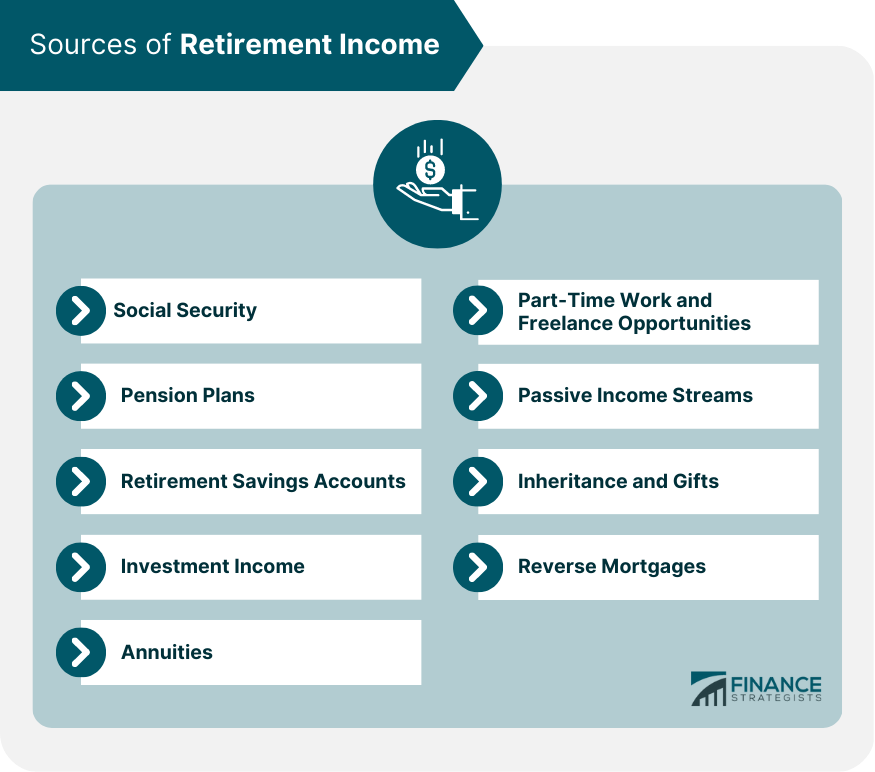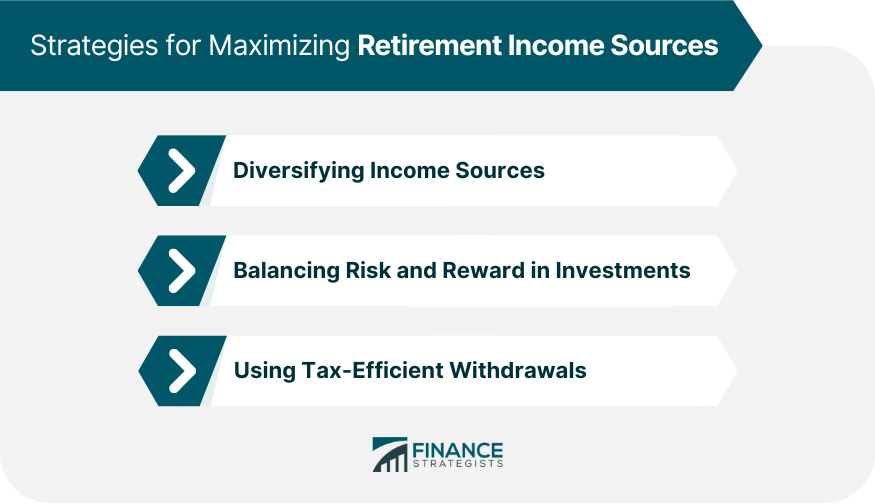Diversifying retirement income sources is essential for ensuring financial security and stability during retirement. A comprehensive retirement income plan that includes various sources of income can help retirees maintain their desired lifestyle, navigate market fluctuations, and reduce the risk of outliving their savings. Creating a comprehensive retirement income plan involves identifying and maximizing various income sources while considering individual financial goals, risk tolerance, and retirement timeline. Social Security benefits provide a guaranteed monthly income during retirement, based on an individual's earnings history and the age at which they start claiming benefits. For many retirees, Social Security is a significant source of retirement income and serves as a financial safety net. Maximizing Social Security income involves strategic planning, including delaying the start of benefits until the full retirement age or beyond, which can result in higher monthly payments. Additionally, understanding the impact of working during retirement and coordinating spousal benefits can help retirees get the most from their Social Security benefits. Defined benefit plans, also known as traditional pension plans, provide a fixed monthly benefit during retirement, based on factors such as salary, years of service, and a predetermined formula. Defined contribution plans, such as 401(k) and 403(b) plans, are employer-sponsored retirement savings plans in which employees contribute a portion of their earnings, often with employer matching contributions. The retirement benefit is based on the account balance and investment performance. Retirees with pension benefits must consider factors such as payment options (e.g., single-life annuity, joint-life annuity) and potential tax implications when determining how to incorporate pension income into their retirement plan. Traditional 401(k) plans allow employees to contribute pre-tax earnings to their retirement account, with potential employer matching contributions. Withdrawals during retirement are taxed as ordinary income. Roth 401(k) plans allow employees to contribute after-tax earnings, with tax-free withdrawals during retirement, provided certain conditions are met. Traditional IRAs are individual retirement savings accounts that offer tax-deferred growth, with contributions potentially tax-deductible and withdrawals taxed as ordinary income during retirement. Roth IRAs are individual retirement savings accounts that provide tax-free growth and withdrawals during retirement, provided certain conditions are met. 403(b) plans are similar to 401(k) plans but are designed for employees of non-profit organizations, public schools, and certain religious institutions. 457 plans are deferred compensation plans for state and local government employees and certain non-profit employees, offering similar benefits to 401(k) and 403(b) plans. SIMPLE IRAs are employer-sponsored retirement savings plans designed for small businesses, allowing both employee and employer contributions. SEP IRAs are employer-sponsored retirement savings plans that allow employers to make tax-deductible contributions on behalf of eligible employees. Investing in dividend-paying stocks, bonds, and other interest-bearing accounts can generate income during retirement, supplementing other sources. Selling investments, such as stocks and real estate, at a profit can generate capital gains, which can be used to supplement retirement income. Individuals should consider the tax implications of realizing capital gains. Owning rental properties can provide a steady stream of passive income through rental payments, which can supplement other retirement income sources. REITs own and manage income-producing real estate properties. Investing in REITs can provide retirees with passive income through dividends and potential capital appreciation. These are financial products purchased with a lump sum that provides a guaranteed income stream, starting at the onset of purchase. The income can be structured to last for a specified period or for the remainder of the annuitant's life. Deferred annuities are financial products that accumulate earnings on a tax-deferred basis until they are annuitized. At this point, it provides a guaranteed stream of income for a specified period or the remainder of the individual’s life. Retirees should consider factors such as payout options (e.g., single-life, joint-life), potential fees, and the financial strength of the insurance company when evaluating annuity products for their retirement income plan. Working part-time or freelancing during retirement can provide additional income, social interaction, and a sense of purpose, helping retirees maintain a higher quality of life. Retirees can explore various part-time or freelance opportunities, such as consulting, tutoring, or pursuing a passion project, to supplement their retirement income. Owning a business or investing in a business venture can generate passive income during retirement. However, retirees should carefully consider the risks and potential time commitment involved in such ventures. For retirees with intellectual property, such as patents, copyrights, or trademarks, royalties from licensing agreements can provide passive income during retirement. Inheritance from a deceased family member or friend can provide a financial boost to a retiree's income. However, relying solely on inheritance can be unpredictable and should not be the primary source of retirement income. Retirees should know potential tax implications related to inheritances and gifts, such as estate and gift taxes. Individuals should consult with a tax professional when necessary. Reverse mortgages allow homeowners aged 62 or older to convert a portion of their home equity into a loan, providing a source of income during retirement. The loan is repaid when the homeowner sells the home, moves out, or passes away. While reverse mortgages can provide a source of income during retirement, they also come with potential drawbacks, such as high fees, interest charges, and reduced home equity for heirs. Retirees should carefully consider their options before deciding on a reverse mortgage. Retirees can reduce financial risks and ensure a steady income by diversifying their retirement income sources, including a mix of Social Security benefits, pension income, investment income, and part-time work. A balanced investment portfolio that includes stocks, bonds, and other assets can help retirees achieve long-term growth while managing risk. Retirees should consider their risk tolerance, financial goals, and time horizon when building their investment portfolio. Retirees can optimize their retirement income by implementing tax-efficient strategies, such as withdrawing from taxable and tax-deferred accounts, considering Roth conversions, and managing required minimum distributions (RMDs). Financial advisors can help retirees develop a comprehensive retirement income plan, taking into account individual financial goals, risk tolerance, and retirement timeline. Certified Financial Planners (CFPs) are financial professionals with specialized training in retirement planning, investment management, and other areas of personal finance. They can provide expert guidance on optimizing retirement income sources. Retirement income planning specialists focus on helping individuals develop strategies for maximizing their retirement income, considering factors such as Social Security benefits, pension plans, and investment portfolios. Diversifying retirement income sources is essential for ensuring financial security and stability during retirement. A well-rounded retirement income plan can help individuals maintain their desired lifestyle, navigate market fluctuations, and reduce the risk of outliving their savings. By understanding the various retirement income sources and strategies for maximizing income, retirees can develop a personalized retirement income plan that meets their unique financial needs and goals. Individuals should regularly review and adjust their retirement income strategies to account for changes in their financial situation, economic environment, and personal circumstances. Working with financial professionals can help individuals stay on track and achieve their retirement goals.Retirement Income Sources: Overview
Social Security
Understanding Social Security Benefits
Strategies for Maximizing Social Security Income
Pension Plans
Types of Pension Plans
Defined Benefit Plans
Defined Contribution Plans
Pension Benefit Options and Considerations
Retirement Savings Accounts
401(k) Plans
Traditional 401(k) Plans
Roth 401(k) Plans
Individual Retirement Accounts (IRAs)
Traditional IRAs
Roth IRAs
Other Retirement Savings Vehicles
403(b) Plans
457 Plans
SIMPLE IRAs
SEP IRAs
Investment Income
Dividends and Interest
Capital Gains
Real Estate Investments
Rental Properties
Real Estate Investment Trusts (REITs)
Annuities
Types of Annuities
Immediate Annuities
Deferred Annuities
Annuity Payment Options and Considerations
Part-Time Work and Freelance Opportunities
Benefits of Working During Retirement
Finding Suitable Part-Time or Freelance Work
Passive Income Streams
Creating Passive Income Through Business Ventures
Intellectual Property Royalties
Inheritance and Gifts
Inheritance as a Retirement Income Source
Tax Considerations for Inheritances and Gifts
Reverse Mortgages
How Reverse Mortgages Work
Pros and Cons of Using a Reverse Mortgage for Retirement Income

Strategies for Maximizing Retirement Income Sources
Diversifying Income Sources
Balancing Risk and Reward in Investments
Using Tax-Efficient Withdrawals

Working With Financial Professionals
Financial Advisors
Certified Financial Planners (CFPs)
Retirement Income Planning Specialists
Conclusion
Retirement Income Sources FAQs
The primary sources of retirement income include Social Security benefits, pension plans, retirement savings plans (such as 401(k) or IRA), personal savings and investments, and annuities.
The amount of income you can expect from Social Security in retirement depends on your earnings history and when you start receiving benefits. You can estimate your Social Security benefits using the Social Security Administration's online calculator.
A pension plan is a retirement plan that provides a fixed income stream to retirees based on their years of service and salary. Employers typically contribute to a pension plan on behalf of their employees, and the plan pays out benefits to retirees for the rest of their lives.
Retirement savings plans allow individuals to save money for retirement on a tax-advantaged basis. The money saved in these plans can be invested in stocks, bonds, mutual funds, or other investment vehicles. In retirement, the savings can be withdrawn and used to provide retirement income.
An annuity is an insurance product that provides a guaranteed income stream for life or a set period of time in exchange for a lump-sum payment or series of payments. Annuities can be purchased from insurance companies and can provide a steady source of retirement income, especially for those who are concerned about outliving their retirement savings.
True Tamplin is a published author, public speaker, CEO of UpDigital, and founder of Finance Strategists.
True is a Certified Educator in Personal Finance (CEPF®), author of The Handy Financial Ratios Guide, a member of the Society for Advancing Business Editing and Writing, contributes to his financial education site, Finance Strategists, and has spoken to various financial communities such as the CFA Institute, as well as university students like his Alma mater, Biola University, where he received a bachelor of science in business and data analytics.
To learn more about True, visit his personal website or view his author profiles on Amazon, Nasdaq and Forbes.











